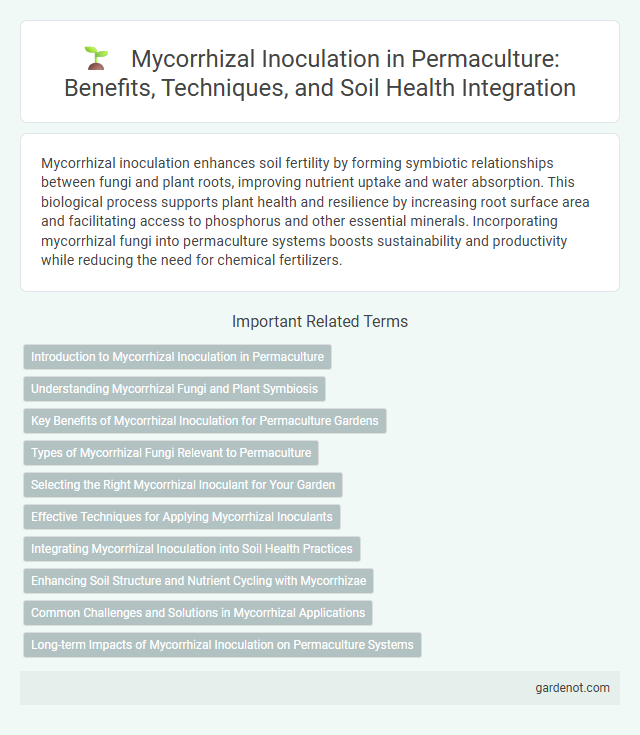Mycorrhizal inoculation enhances soil fertility by forming symbiotic relationships between fungi and plant roots, improving nutrient uptake and water absorption. This biological process supports plant health and resilience by increasing root surface area and facilitating access to phosphorus and other essential minerals. Incorporating mycorrhizal fungi into permaculture systems boosts sustainability and productivity while reducing the need for chemical fertilizers.
Introduction to Mycorrhizal Inoculation in Permaculture
Mycorrhizal inoculation enhances plant growth by introducing symbiotic fungi that improve nutrient and water absorption in permaculture systems. These fungi form extensive networks connecting plant roots, increasing soil fertility and resilience naturally without chemical fertilizers. Incorporating mycorrhizal inoculation supports sustainable ecosystems by promoting healthy plant development and biodiversity in permaculture gardens.
Understanding Mycorrhizal Fungi and Plant Symbiosis
Mycorrhizal inoculation enhances plant growth by introducing beneficial fungi that form symbiotic relationships with plant roots, improving nutrient and water absorption. These fungi extend the root system's reach, facilitating access to phosphorus and trace minerals essential for plant health. Understanding the role of mycorrhizal fungi in soil ecosystems is crucial for optimizing permaculture design and promoting sustainable, resilient plant communities.
Key Benefits of Mycorrhizal Inoculation for Permaculture Gardens
Mycorrhizal inoculation enhances soil fertility by establishing symbiotic relationships between fungi and plant roots, improving nutrient uptake such as phosphorus and nitrogen essential for permaculture plants. This bio-enhanced root system increases water absorption efficiency and drought resistance, vital for sustainable garden productivity. Promoting soil structure and microbial diversity, mycorrhizal fungi contribute to long-term ecosystem resilience and healthier plant growth in permaculture gardens.
Types of Mycorrhizal Fungi Relevant to Permaculture
Arbuscular mycorrhizal fungi (AMF) form symbiotic relationships with the roots of most herbaceous plants, improving nutrient uptake and soil structure in permaculture systems. Ectomycorrhizal fungi (EMF) are primarily associated with woody plants and trees, enhancing phosphorus absorption and disease resistance. Endomycorrhizal fungi, including vesicular-arbuscular mycorrhizae, are crucial for promoting plant health and resilience across diverse permaculture landscapes.
Selecting the Right Mycorrhizal Inoculant for Your Garden
Selecting the right mycorrhizal inoculant for your garden involves identifying the specific fungal species that form symbiotic relationships with your plants, such as arbuscular mycorrhizae for most vegetables and trees. Consider inoculants with proven strains like Glomus intraradices or Glomus mossae to enhance nutrient uptake, soil structure, and drought resistance. Matching inoculant type with soil conditions and plant variety ensures optimal colonization and long-term garden productivity.
Effective Techniques for Applying Mycorrhizal Inoculants
Mycorrhizal inoculation enhances plant nutrient uptake and soil health by introducing beneficial fungi to root zones. Effective techniques for applying mycorrhizal inoculants include root dipping before transplanting, soil drenching near the root system, and incorporating inoculants into planting holes to ensure close root-fungus contact. Using high-quality, species-specific inoculants in combination with organic mulch further promotes successful mycorrhizal colonization in permaculture systems.
Integrating Mycorrhizal Inoculation into Soil Health Practices
Integrating mycorrhizal inoculation into soil health practices enhances nutrient uptake and improves plant resilience by establishing symbiotic relationships between fungi and plant roots. This process increases soil microbial diversity, boosts organic matter decomposition, and supports sustainable permaculture systems. Applying mycorrhizal fungi spores or colonized root fragments during planting optimizes root growth and soil structure, promoting long-term soil fertility and ecosystem stability.
Enhancing Soil Structure and Nutrient Cycling with Mycorrhizae
Mycorrhizal inoculation significantly improves soil structure by promoting the formation of soil aggregates through fungal hyphae, which enhance aeration and water retention. These symbiotic fungi extend the root system's reach, facilitating efficient nutrient cycling by mobilizing phosphorus, nitrogen, and other essential minerals. Incorporating mycorrhizae into permaculture systems fosters resilient ecosystems with enriched soil fertility and sustainable plant growth.
Common Challenges and Solutions in Mycorrhizal Applications
Mycorrhizal inoculation often faces challenges such as low colonization rates due to soil disturbances, unsuitable environmental conditions, and competition from native microbes. Effective solutions include selecting region-specific mycorrhizal strains, optimizing soil pH and organic matter content, and minimizing the use of chemical fertilizers and pesticides that can inhibit fungal growth. Employing proper inoculation techniques and timing, such as applying inoculants during transplanting or early plant development stages, enhances symbiotic establishment and overall plant health.
Long-term Impacts of Mycorrhizal Inoculation on Permaculture Systems
Mycorrhizal inoculation enhances soil structure and nutrient cycling, promoting resilient plant growth in permaculture systems over time. It fosters symbiotic relationships between fungi and plant roots, increasing water retention and reducing the need for synthetic fertilizers. Long-term impacts include improved biodiversity, ecosystem stability, and increased crop yields sustainably within permaculture designs.
Mycorrhizal inoculation Infographic

 gardenot.com
gardenot.com